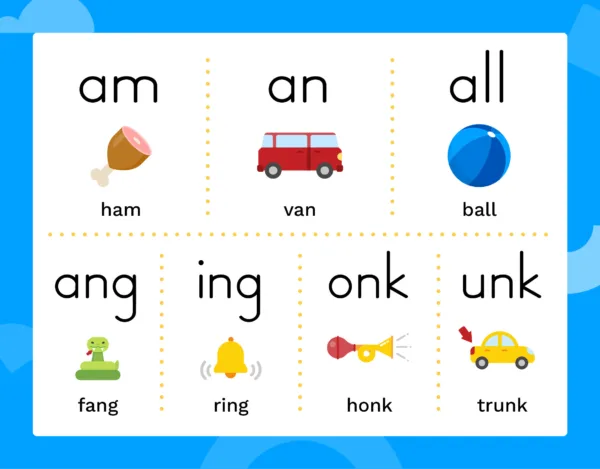Glued Sounds: A Quick Introduction
Parareading Course 2: Phonics for Paraprofessionals

Paras Know!
Notice how the vowel sounds change in the pronunciation of these words. It is important to help students identify and segment all the phonemes in words as they learn these glued sound patterns. Make sure to include phoneme segmentation when you teach these units.
Notice how the vowel sounds change in the pronunciation of these words. It is important to help students identify and segment all the phonemes in words as they learn these glued sound patterns. Make sure to include phoneme segmentation when you teach these units.
Let's Watch! Ashton Smith, a teacher at Hope-Hill Elementary School in Atlanta, goes over the glued sounds /an/ and /am/ with her kindergartners. She shows them how the ‘a’ sound changes slightly when it’s followed by ‘n’ and ‘m’, and she uses flash cards to help them remember the new patterns.

Hide Video Transcript
Show Video Transcript
Ashton Smith: We are going to do our deck. Lemme see whose eyes are on me. Who's crisscross?
Narrator: Kindergarten teacher Ashton Smith is reviewing glued sounds with her students today. They're focusing on how the short 'a' sound changes slightly. When the 'a' is followed by 'n' or 'm'.
Ashton Smith: What does 'a' say?
Students: /ă/.
Ashton Smith: What does 'n' say?
Students: /n/.
Ashton Smith: What does 'm' say?
Students: /m/.
Ashton Smith: And when you say 'm', your lips are together. So lemme say...
Ms. Smith and Students: /m/.
Ashton Smith: When you say 'n', your lips are not together. Say /n/.
Students: /n/.
Ashton Smith: Now, when 'a' is with 'n', the 'n' makes 'a' say something a little funny. So it's not going to say, /ă/. So we're going to call this a glued sound. They're glued together. So lemme hear you say 'a', 'n', van, '-an'.
Students: 'A', 'n', van, '-an'.
Ashton Smith: So when you see "an" together in a word, it's a chunk. It's glued together and you're just going to read it '-an'. So let's try it again.
Narrator: Ms. Smith's direct and explicit instruction helps her students remember that 'a' is going to sound a little different, neither long nor short, when they see it in words like ham and can.
Ashton Smith: Very good. Now guess what? There's another one.
Students: 'a', 'm'. '-am'.
Ashton Smith: '-am'. So when we see 'a', 'm' together in a word, we're not going to say, /ă/, /m/. We're going to take the glued sound or the chunk and we're going to read it together. Okay? So let's try this. 'A', 'm', ham, '-am'.
Students: 'A', 'm', ham, '-am'.
Narrator: This review is setting the stage for a reading fluency lesson, focusing on these sounds.
Reading Universe is made possible by generous support from Jim and Donna Barksdale, the Hastings/Quillin Fund, an advised fund of the Silicon Valley Community Foundation, the AFT, the Emily Hall Tremaine Foundation, and anonymous donors. Special thanks to Hope Hill Elementary, Reading Is Essential for All People, and Atlanta Public Schools. If you enjoyed this video, please subscribe to our YouTube channel @RUTeaching. Reading Universe is a service of WETA Washington, D.C., the Barksdale Reading Institute, and First Book.
Ashton Smith: My name is Ashton Smith and this is Reading Universe.


